Gramma Pie really is an absolute slice of nostalgia – and so darn delicious. If you know what it is, it's likely you have lived in NSW or Queensland and your nan or mum made it every year when she could get her hands on a gramma.
This Gramma Pie recipe is based on what I've pieced together about my Nan's Gramma Pies and some research on recipes shared among Aussie home cooks in the early to mid 1900s.
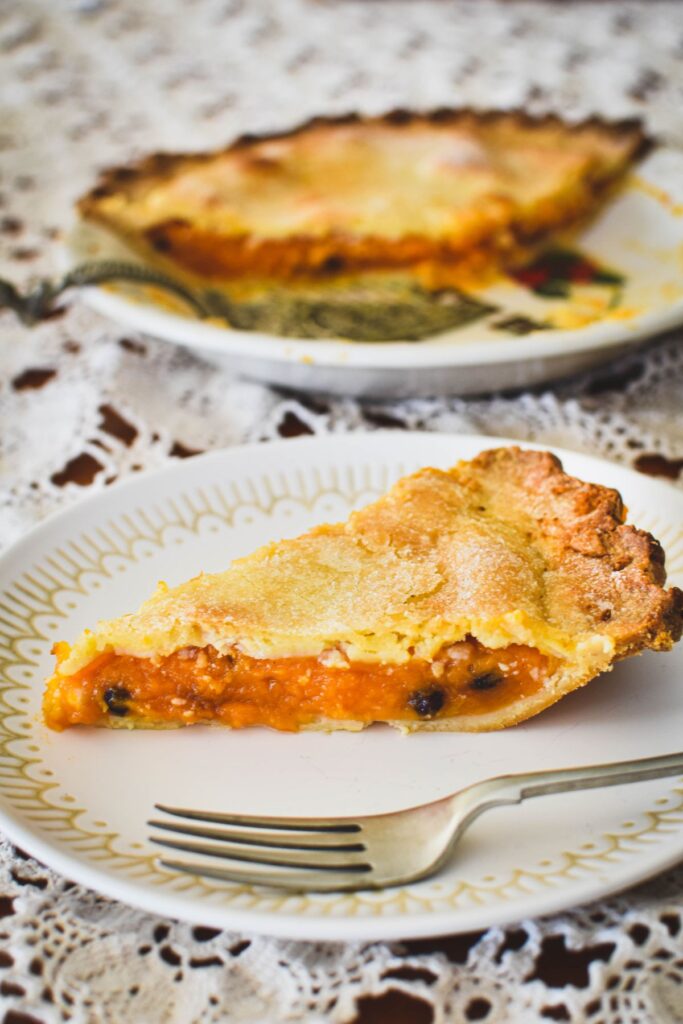
What is gramma?
First, if you weren't lucky enough to grow up on Gramma Pie, you might be wondering what a gramma is.
When I recently shared a photo of a chunk of gramma on my Facebook page, asking people if they knew what it was, I sparked an interesting discussion about whether gramma is a pumpkin or something else.
Some people were absolutely convinced I was completely bonkers and was calling a Kent Pumpkin a gramma.
I've always been told that gramma is not a pumpkin – even though it looks like one – but is rather a squash.
A pretty special squash, too.
Because where I live, in the Hunter Valley, gramma is... gramma. It's in a category all of its own.
And when it's in a pie, it's something quite magical.
Here are some Facebook Marketplace ads for grammas for sale locally.
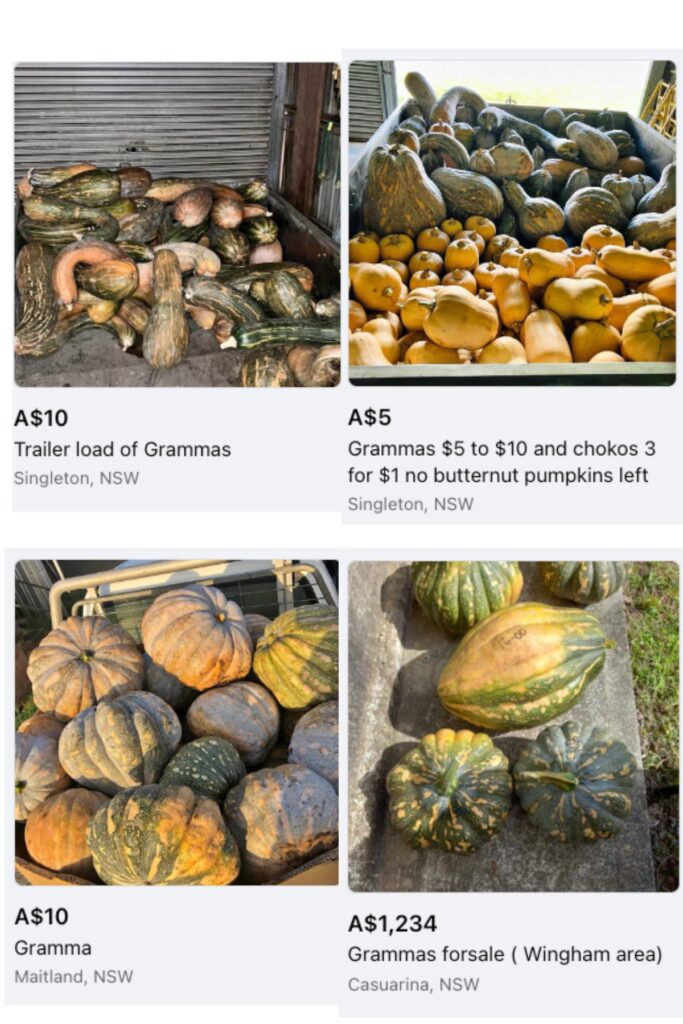
The gramma is similar to a pumpkin, I admit.
But when you cook with it, you realise it is quite distinct.
It's far less dense and so much easier to chop.
The colour is a brighter orange and the fibrous insides are also less dense.
The Australian Food Timeline website also tackles the gramma debate, saying:
"Although references to gramma squash can be found in Newcastle market reports from the 1850s, the vegetable had almost certainly been grown in Australia decades earlier. The earliest published recipe I can find for gramma pie appeared in the Australian Town and Country Journal, Sydney, in 1885. Although it gets a mention in Mrs Beeton’s section on Australian cookery in the 1891 edition, the dish seems to have remained unknown to many beyond the north coast of New South Wales."
Recipe for Old fashioned Gramma Pie
The Australian Food timeline also notes that my local paper, the Maitland Daily Mercury, recorded the regional nature of gramma pie in 1936: “The best kind of pie in the world…but it takes the people of the North Coast to make them.”
My Nan Mac was definitely one of those North Coasters who could make a Gramma Pie!
So, after I was given a lovely chunk of gramma from my Aunty Judy, I did a little asking around to find out how Nan Mac made her gramma pies before attempting to recreate this much-loved dessert.
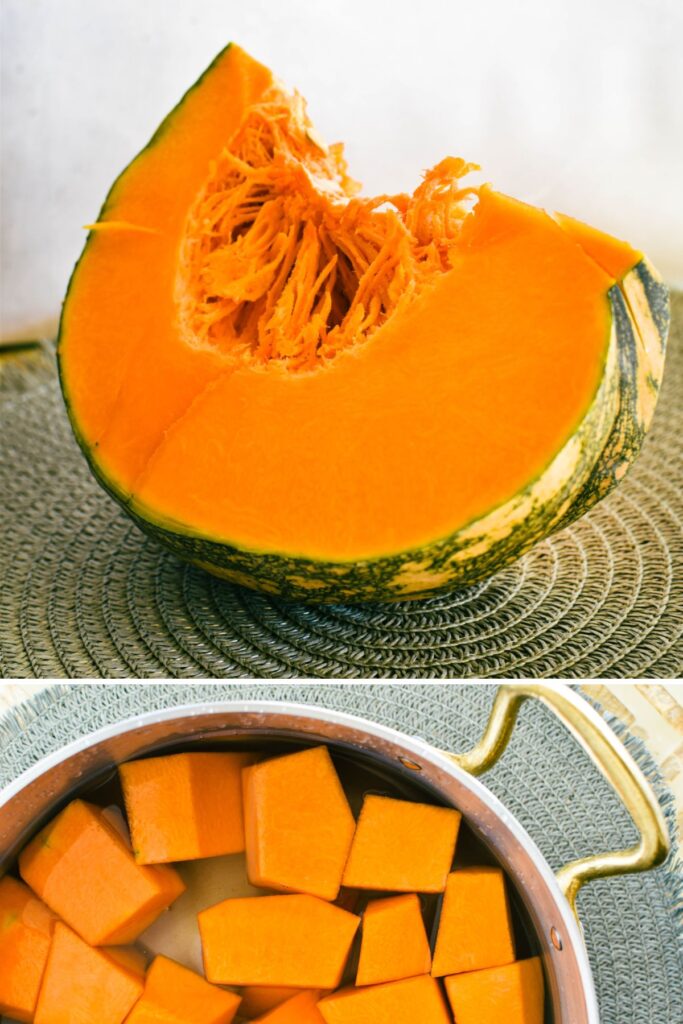
Ingredients for Gramma Pie
To make the gramma filling, you'll need:
- 1 kg gramma (peeled, seeded and chopped) (I'm told Aussie sunset pumpkin and Butternut pumpkin are the closest substitutes but have never tried this myself)
- caster sugar
- lemon
- currants (optional, and sultanas can also be substituted – but my mum loves currants in gramma pie and I also think it makes the pie look that extra bit delicious)
- cloves and cinnamon (optional, mum said Nan Mac didn't add any spices but I couldn't help but add just a little something, and I found these spices were often mentioned in the very early recipes for gramma pie)
- a little milk and extra sugar (to brush and sprinkle on top of pastry).
You'll also need sweet shortcrust pastry. You can opt for frozen store-bought sheets or make my Sweet Shortcrust Pastry recipe.
All ingredients and quantities can be found in the recipe card at the end of this post.
How to make Gramma Pie
Okay, let's do it!
I won't go through the steps for the pastry, as you can buy the packaged pastry or find out how to make a lovely shortcrust for this pie over here.
Gramma Pie filling
Once you've found yourself a gramma (or decided to experiment with an Aussie sunset or Butternut pumpkin), peel it, seed it and chop into small-ish chunks.
Cover the gramma with water and bring to the boil.
Simmer for about 30 minutes or until very tender.
The cooking time will really depend on the gramma and the size of the chunks you've cut.
Once cooked and tender, place in a large sieve and allow to drain until the gramma has cooled completely.
This is an important step, as you want to remove as much water as possible from the cooked gramma.
Place drained gramma into a bowl and mash well. Add the currants, lemon juice and a little zest, before adding sugar and stirring until combined.
Let's make pie!
Start by pre-heating the oven to 180 degrees celsius (fan-forced).
Next, grease a pie dish (approx 25cm) with butter.
Fill the bottom of the pie dish with pastry, trimming sides to fit.
Fill with the gramma filling mixture.
Place pastry top onto pie and form a crust by pressing with a fork or pushing your thumb into pastry to create a ripple pattern (see picture below).
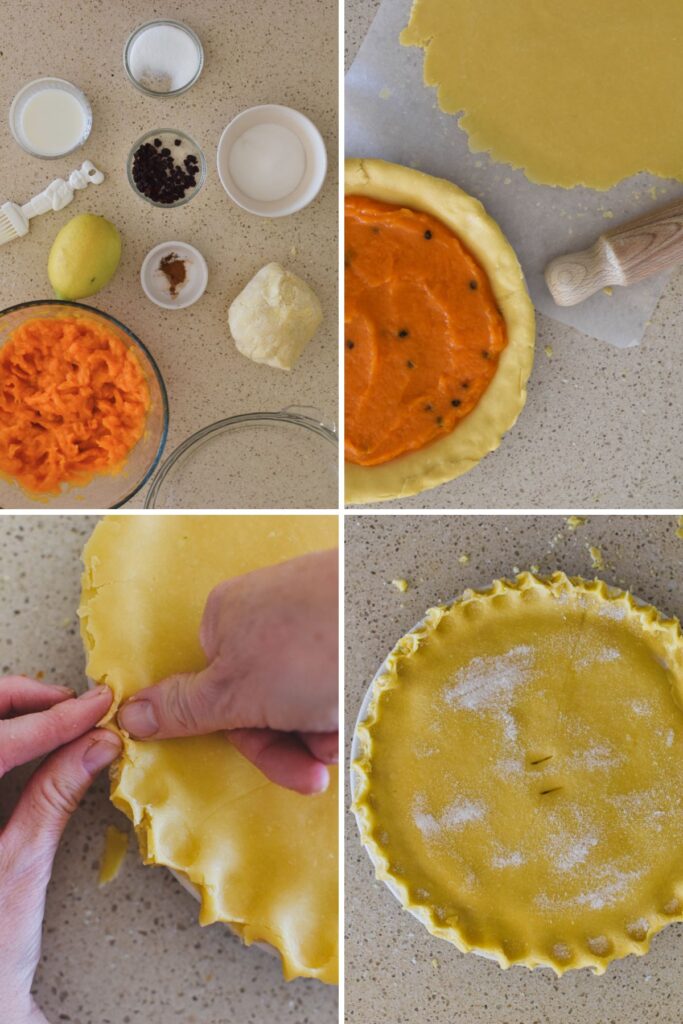
Brush the top of the pie with milk and sprinkle with additional sugar.
Use a sharp knife to insert two small slits into the middle of the pie.
Bake for 45–60 minutes or until golden.
Serving Gramma Pie
Allow to cool a little before serving the pie warm with ice cream, cream or custard.
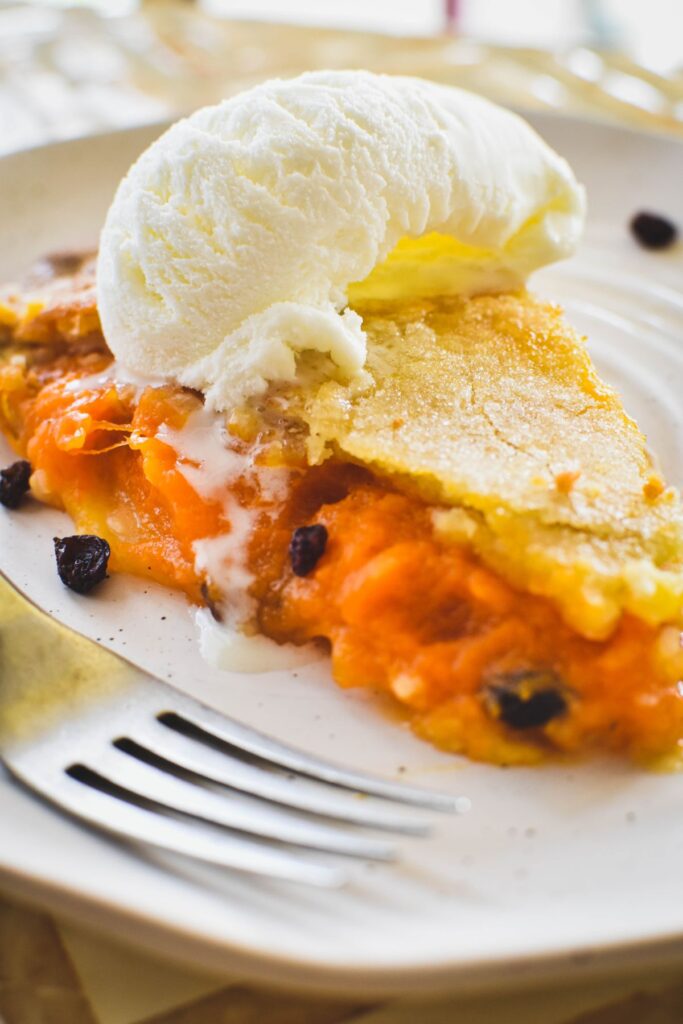
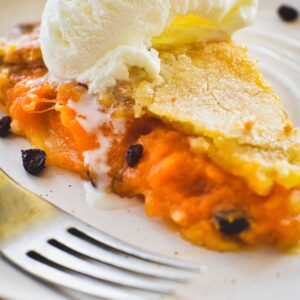
Gramma Pie
Equipment
- pie dish (25 cm approx)
Ingredients
Sweet Shortcrust Pastry
- 125 grams butter
- 120 grams icing sugar (¾ cup)
- 1 egg yolk
- 3-4 teaspoons lemon juice
- 1 ½ cups plain flour (all purpose flour) (230 grams)
- 1 pinch salt
Gramma Filling
- 1 kg gramma (peeled, seeded and chopped)
- ⅓ cup caster sugar
- 1 medium lemon (¼ cup juice plus a little zest)
- 1 tablespoon currants
- 1 pinch cloves
- 1 pinch cinnamon
- a little milk and extra tablespoon sugar (to brush and sprinkle on top of pastry)
Instructions
Pastry
- Take butter from fridge and allow to sit for about 30 minutes.
- Chop butter into cubes and beat in a stand mixer on med-high for 1-2 minutes.
- Add icing sugar and mix on low speed until combined. Turn speed to med-high and beat again for 1-2 minutes or until mixture turns a pale colour.
- Add egg yolk and 3 teaspoons of lemon juice and combine with a spatula.
- Fold through sifted flour and salt. The mixture should all be a pale yellow colour with no dry of floury parts. If it seems too dry, add another teaspoon of lemon juice.
- Turn out mixture onto bench and knead lightly to form a ball. Wrap in baking paper and place into the fridge for at least one hour.
Filling
- Cover gramma with water and bring to the boil. Simmer for about 30 minutes or until very tender. (The time will depend on the gramma and the size of the chunks you've cut)
- Once cooked, place in a large sieve and allow to drain until the gramma has cooled completely.
- Place drained gramma into a bowl and mash well. Add currants, lemon juice and a little zest, spices and sugar, stirring until combined.
Pie
- Pre-heat oven to 180 degrees celsius (fan-forced).
- Grease pie dish with butter.
- Remove pastry dough from fridge and break into two pieces – one piece about ⅔ of the whole amount for the base and the rest for the top.
- Roll out the larger portion of dough between two sheets of baking paper until it's large enough to fill the pie dish.
- Place pastry in pie dish and gently press into the dish, trimming sides to fit.
- Fill with gramma filling mixture.
- Roll out the smaller portion of dough between two sheets of baking paper until it's large enough to cover the top of the pie dish.
- Place pastry top onto pie and form a crust by pressing with a fork or pushing your thumb into pastry to create a ripple pattern (see picture above in post).
- Brush with milk and sprinkle with additional sugar.
- Use a sharp knife to insert two small slits into the middle of the pie.
- Bake for 45–60 minutes or until golden.
- Serve warm with ice cream, cream or custard.
Notes
- I'm told Aussie sunset pumpkin and Butternut pumpkin are the closest substitutes for gramma but have never tried this myself.
- Currants, cloves and cinnamon are all optional. Some people also add sultanas, nutmeg or mixed spice.

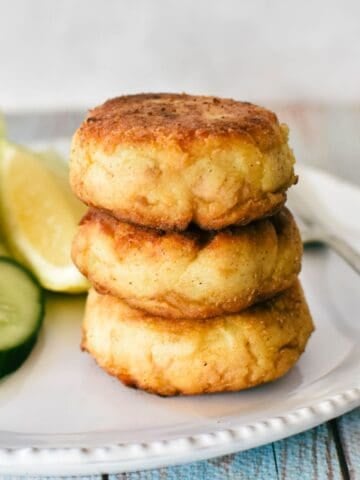
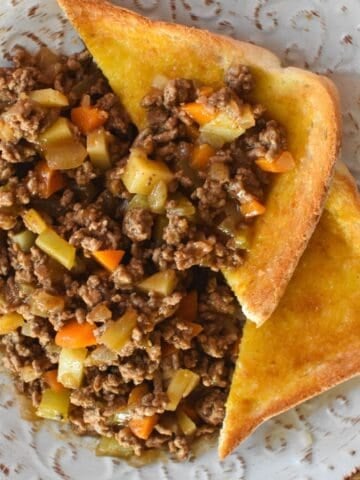
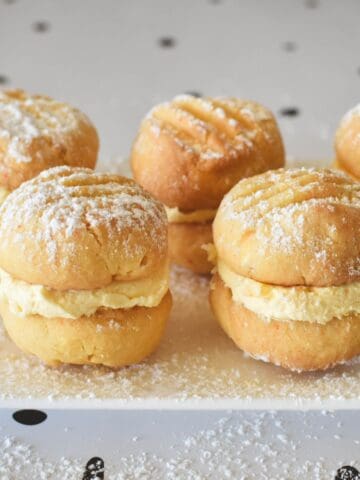
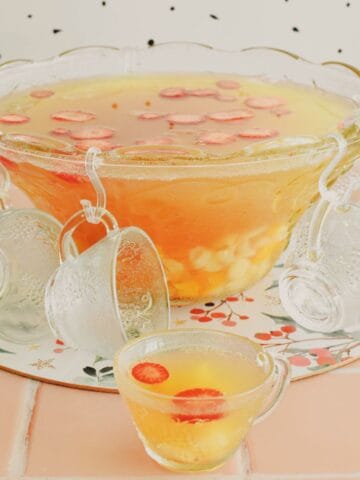
Angela Bennett
Hi Libby,
Hello from Singleton NSW!
I found your recipe after feeling nostalgic about my late Dungog based Gran's Gramma pie. Having not cooked gramma myself, I was wondering if in your experience I might be able to bake slices of the gramma in its rind on baking paper, rather than boiling it?
I am wondering if baking might be an option to avoid making it so wet using the boiling method, but also wondering whether its inherent squash stringiness is the reason it is usually boiled to make a gramma pie filling?
Thanks in advance for any advice you can offer,
Angela.
Libby Hakim
Hi Angela! Just up the road! Love a trip to Singleton, there are some nice little cafes there 🙂 Hmmm, my nana always boiled the gramma and I've just flicked through some other gramma pie recipes which all suggest boiling it. But it is important to let it drain completely. In the recipe I suggest allowing it to drain until it cools. Boiling makes vegetables much softer than baking, so I'd expect it wouldn't work so well for a pie filling. Similar to apple pie, I wouldn't suggest baking the apples but always stewing them for pie. If you do decide to experiment, I'd love to hear how it goes. Happy cooking! Libby x
Bec
Just making this now and a bit confused with the way the recipe is written...the pastry part of your method requires blind baking...but then as you get to the filling section is sounds like you fill into the raw pastry???? Should i blind bake or no?
Libby Hakim
So sorry, Bec. It should make a lot more sense now. No blind baking involved. There was a stray set of instructions in there. Hope it all went well and you enjoyed your pie!